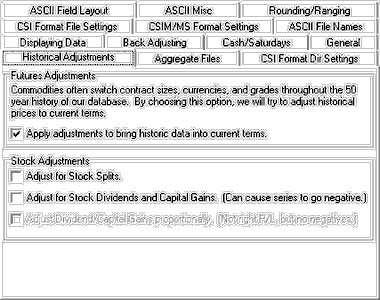Futures Adjustments
UA maintains a file of adjustments that can be applied to raw market data to bring historical prices into the same terms as current prices. The adjustment file (called UA\ARCHIVES\cdbadjst.adm) holds multipliers to adjust for changes in contract size, trading units, or other contract specifications.
We recommend these adjustments be applied to the database, and therefore have made this the default response.
This option is handled through the "Historic Adjustments" tab of Portfolio settings as shown below. If you do not wish to use the adjustments, click the box to remove the check.

Stock Adjustments
Long-term charting and analysis of the stock market can be greatly enhanced by adjusting historical data to reflect stock splits, dividends and capital gains. These are very relevant to the value of the stock, but would not be appropriately reflected in raw price series. UA maintains statistics on all splits, capital gains and dividends so that adjustments can be made without affecting the raw price data in the database.
These options are handled through the "Historic Adjustments" tab of your portfolio settings as shown above. If you wish to change the settings, check or uncheck the boxes as desired.
Adjust for stock splits - Adjusts the data prior to the split using an appropriate multiplier to force a smooth transition from pre-split data to post-split data. For example, in a 2 for 1 split, which would normally result in the stock price falling by 50%, the pre-split data would be multiplied by .5.
Adjust for stock dividends and capital gains - Much like the split adjustment, an appropriate value is subtracted to compensate for the value removed from the stock price by the dividend or distribution. Due to the effects of inflation, this method can cause adjusted stock prices to fall below zero. Negative values are not accepted by some trading systems.
Adjust Dividend/Capital Gain proportionally (Not right P/L, but no negatives) - This adjustment method also smoothes the transition from pre-distribution prices to post-distribution prices, but the adjustment is based on the dividend or capital gain as a percentage of price, not on the dollar value actually paid to shareholders. This technique avoids negative values in your adjusted stock file.
